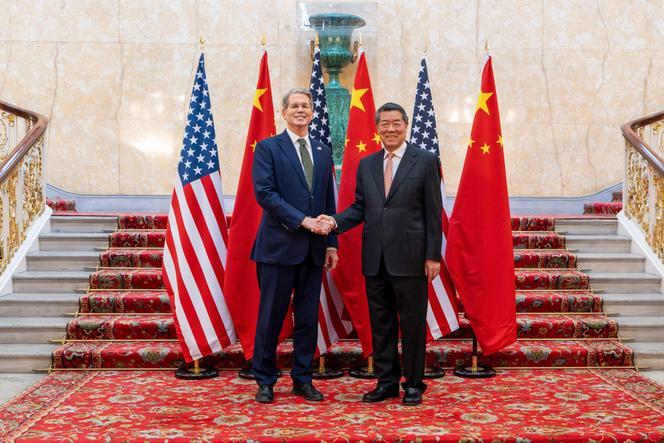In a significant development amid ongoing trade tensions, the United States and China have agreed to collaborate on extending the deadline for their tariff pause, as discussions continue in Stockholm. The move marks a cautious step toward easing economic friction between the world’s two largest economies, with both sides signaling a willingness to maintain dialogue and seek progress ahead of further negotiations. This announcement, reported by AP News, underscores the importance of sustained engagement in steering the complex trade relationship through a critical period.
US and China Commit to Prolonging Tariff Pause Amid Ongoing Trade Negotiations in Stockholm
Representatives from the United States and China have pledged to extend the current tariff pause as both sides continue their intensive trade discussions in Stockholm. This decision aims to maintain a stable trade environment while addressing key issues such as intellectual property rights, technology transfers, and market access. The extension signals a mutual willingness to work toward a comprehensive agreement that could alleviate ongoing economic tensions between the world’s two largest economies.
Key points highlighted during the talks include:
- Commitment to fairness: Both parties emphasized transparency and reciprocity in trade practices.
- Technology cooperation: A shared interest in regulating emerging technologies to prevent unfair advantages.
- Trade balance efforts: Strategic steps to improve bilateral trade balance without compromising national interests.
| Aspect | US Position | China Position |
|---|---|---|
| Tariff Pause Duration | Extend by 3 months | Support extension with review |
| Intellectual Property | Stronger enforcement | Commit to improved protection |
| Market Access | Increase opportunities for US firms | Gradual opening of sectors |
Implications of Tariff Extension for Global Markets and Bilateral Economic Relations
The extension of the tariff pause between the US and China is poised to create ripple effects across global markets, signaling a cautious yet hopeful atmosphere for international trade. By postponing the reimposition of tariffs, both economic powerhouses aim to stabilize supply chains and reduce uncertainties for businesses operating in affected sectors. This development is expected to:
- Enhance investor confidence as volatility in stock markets linked to trade tensions may subside.
- Support recovery for industries heavily reliant on multinational supply networks, such as electronics and automobiles.
- Encourage third-party countries to strengthen economic ties with both nations, benefiting from a more predictable trade environment.
On the bilateral front, the agreement underscores a mutual acknowledgment of the need for dialogue and pragmatism amid ongoing disputes. While deep-rooted issues remain, the extension creates a vital window for both governments to explore long-term solutions. Analysts highlight the following anticipated outcomes for Sino-American relations:
| Aspect | Expected Impact |
|---|---|
| Trade Negotiations | Renewed momentum for comprehensive agreements |
| Diplomatic Engagement | Increased communication channels and trust-building |
| Technology Sector | Potential easing of restrictions and collaborations |
| Economic Competitiveness | Balanced approach to safeguarding national interests |
Recommendations for Stakeholders to Navigate Uncertainties in US China Trade Dynamics
Amid ongoing negotiations, stakeholders must prioritize agility and strategic foresight to effectively manage the evolving trade landscape between the US and China. Companies and policymakers should diversify supply chains to reduce dependency risks, leveraging alternative markets and regional partnerships. This approach helps mitigate the impact of sudden tariff adjustments or regulatory shifts during the extended pause period. Additionally, maintaining transparent communication channels with trade authorities ensures timely responses to policy changes and fosters collaborative problem-solving.
Investors and businesses are encouraged to enhance their scenario planning capabilities, incorporating dynamic risk assessments aligned with geopolitical indicators. Engaging in active dialogue with legal and economic experts will help decode nuanced implications of any future agreements or disputes. The table below outlines key focus areas for stakeholders navigating the uncertain environment:
| Stakeholder | Recommended Action | Potential Benefit |
|---|---|---|
| Manufacturers | Diversify supply base | Reduced disruption risk |
| Investors | Scenario-based portfolio reviews | Improved risk management |
| Policymakers | Maintain open dialogues | Enhanced negotiation outcomes |
| Legal Advisors | Proactive compliance checks | Minimized regulatory penalties |
In Retrospect
As negotiations continue in Stockholm, the agreement between the United States and China to explore extending the current tariff pause marks a cautious but significant step toward easing trade tensions. Both sides remain committed to dialogue, signaling a potential thaw in one of the world’s most critical economic relationships. Observers will be watching closely to see if these discussions can translate into substantive progress and a more stable trading environment in the months ahead.




